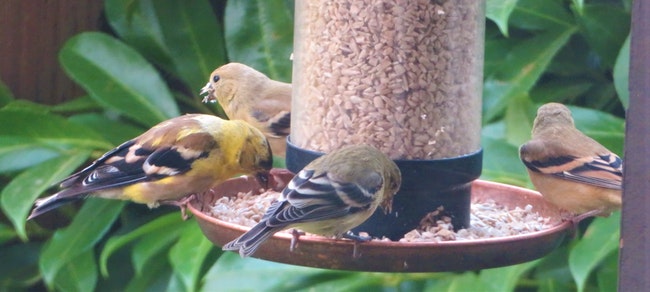
American goldfinches in molt (Harry Fuller/Special to Salem Reporter)
Birds have unique characteristics setting them apart from other animals. Perhaps the most central: feathers. They are formed from keratin, a lightweight, fibrous protein. Feathers’ strength with minimal weight is crucial for birds. Keratin shapes hair and fur, horns, claws, hoofs and our species’ fingernails as well.
Feathers vary in shape and size, adapted to specific purposes. Tightly overlapped on the outside, feathers waterproof and insulate. Soft, fluffy feathers next to the skin offer padding, insulation, protection from friction. Long wing and tail feathers enable flight and navigation. An eagle soars on a few ounces of wing feathers.
Flight precision requires that each feather has its own muscle just under the skin. Each feather can adjust as required. Wintering birds and waterfowl can trap air between feather layers. It helps keep birds warm and makes swimmers buoyant. Then, a diving grebe can tighten feathers to push out the air, allowing faster and deeper diving.
A feather’s core quill is hollow as are birds’ bones. Any pilot will tell you: when flying, weight is a crucial concern.
Feathers are the birds’ costume before the world. We are all familiar with the showy tails of male turkeys, roosters or peacocks. There are crests on the cardinal, titmouse, Steller’s jay, phainopepla. There is the bald head of the turkey vulture, the bare legs of heron, egrets, flamingos. There are bold colors of parrots, warblers, tanagers. There’s iridescent plumage on hummingbirds, a male Mallard’s head, swallows, starlings and many others.
The colors found across the nearly 10,000 species of living birds put the largest box of crayons to shame. Feathers may contain chemical pigments—carotenoids and melanins. Or both combined. Carotenoids add red to yellow hues. Melanins may bring black, gray, brown or buff tones. How do the parrots get their green? Combine yellow and gray.
All sounds simple, like mixing paint, right? But there’s blue, as in bluebirds, scrub-jays, some kingfishers, our biggest heron in Oregon. So—there is no blue pigment. There are miniature structural tricks in “blue” feathers so they absorb most frequencies in the visible spectrum and reflect back only blue. It’s engineered! To put any actress’s wardrobe to shame, birds’ raiment often includes ultraviolet colors that our limited vision cannot see.
Now you may see feathers scattered in your garden or nearby park. Birds remaining for winter molt—old and worn feathers fall off, new ones grow in. In our climate most birds need a new covering before the rainy season and colder weather. Pass the keratin, please.
For information about upcoming Salem Audubon programs and activities, see www.salemsudubon.org, or Salem Audubon’s Facebook page.
Harry Fuller is an Oregon birder and natural history author of “Freeway Birding.” He is a member of the Salem Audubon Society. Contact him at [email protected] or http://www.towhee.net/. His “Some Fascinating Things About Birds” column will be appearing regularly in Salem Reporter.
JUST THE FACTS, FOR SALEM – We report on your community with care and depth, fairness and accuracy. Get local news that matters to you. Subscribe to Salem Reporter starting at $5 a month. Click I want to subscribe!









